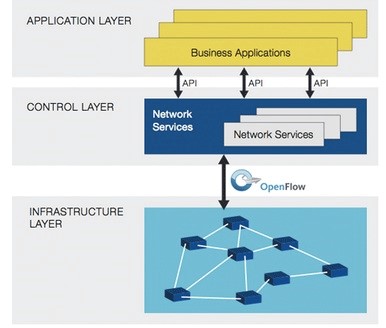Present Blog – IT Thought Leadership
Blog Present-IT thought leadership
Blog Present-IT thought leadership
IT thought leadership blog for CIOs and CTOs in Canada seeking resources to drive IT as a business contributor: hybrid cloud, infrastructure, managed services and security and IT recruitment.
 Nowadays companies are largely defined by technology, that is, they are as agile (or not) as the computer technology they have acquired in the past.
Nowadays companies are largely defined by technology, that is, they are as agile (or not) as the computer technology they have acquired in the past.
This is why many believe that current IT costs too much, and should adopt an approach of a provider of services.
At the data center level, this means that IT must move from a silo model (compute, storage and network) to an integrated, software-defined model, with a common orchestration.
This is what is known as SDDC (Software-Defined Data Center) where the network component may also be programmable with SDC (Software-Defined Network). The essential foundations of this new IT model will be explained by thought leaders at our event on May 7th.
Regarding the networks of enterprise data centers, several challenges must be addressed:
√ Servers and storage have becoming highly virtualized, but their full potential is still constrained by network rigidity.
√ Network utilization remains low, despite congestion at certain times of the day.
√ The network remains complex and costly to manage.
It is in this perspective that SDN (Software-Defined Network) fits in, for which IDC predicts a market growth of 89% on average between 2014 and 2018.
So what is SDN?
Essentially, SDN or a programmable network separates the control part of the network from the infrastructure part of the network that processes and routes data.
In other words, the application tells the SDN controller its requirements and the controller relays the request to an infrastructure that no longer needs to be homogeneous.
Like this, the controller becomes the real brains of the network by providing the following benefits:
√ Transforms the network into a resource that can be easily provisioned and programmed.
√ Ensures the quality of service, regardless of the infrastructure in place.
√ An easily managed and low cost network, because network administrators have only to manage the parameters and rules at the central controller level, and not at the level of each device.
Programmable networks integrate into the latest generation of data centers, that is to say, Software-Defined Data Centers.

Source : https://www.sdxcentral.com/resources/sdn/what-the-definition-of-software-defined-networking-sdn/
Who are the main players in the market?
SDN aims to change the way companies build their computer networks. Instead of buying routers and switches with lots of features which are very expensive, companies can acquire simpler and less expensive materials, since high-level features are now carried out by a new software layer.
SDN is a trend that is growing in importance, and thus the established vendors such as Brocade, Cisco, HP and VMware, as well as many new companies have jumped onboard.
The fact remains that the technologies behind SDN are recent and standardization is ongoing. OpenFlow, which was developed by the ONF (Open Networking Foundation) is currently the best known protocol.
Define the possible role of SDN in your data center
Given the indisputable benefits and importance of the role of SDN, what approach should IT leaders be taking to prepare for the future?
Consider the following when you start to develop a business case for SDN:
√ Establish if there is a possible alignment between SDN and business needs
√ Identify ROI factors
√ Conduct an implementation risk assessment for a programmable network
√ Establish network performance indicators to show the value of SDN
√ Evaluate the current state of your network to determine if SDN has the ability to improve performance and quality.
In enterprise data centers, virtualization is gradually taking precedence over material and this is helping to define the future of infrastructure. Present is bringing together VMware, the global leader in virtualization and Brocade, a thought leader on SDN, at a unique event that will address the foundations of the new IT model.
About Blog
The right use of technology addresses business challenges and drives business growth in all areas of an enterprise. We hope this blog will offer insight into developing strategies and tactics to enable you to identify those key drivers of growth and keep pace with and anticipate the rapid technology change of today.
Posts by Topic
- IT infrastructure (116)
- IT security (92)
- IT Innovation (59)
- Trends (51)
- Cloud (47)
- Managed services (46)
- Mobility (38)
- Digital transformation (29)
- CIO/IT leaders (28)
- Events (28)
- News (23)
- Microsoft 365 (17)
- Security (17)
- IBM (16)
- Disaster recovery (DR) (14)
- High availability (12)
- Recruitment (12)
- Storage (12)
- Big Data (11)
- Collaboration (11)
- AI (9)
- Case study (9)
- Office 365 (9)
- BYOD (8)
- Customer Experience (8)
- Hybrid Cloud (7)
- Current events (6)
- SAP Hana (5)
- Business intelligence (BI) (4)
- Converged infrastructure (4)
- Convergence / Hyper-convergence (4)
- Virtualization (4)
- Copilot (3)
- Future of retail (2)
- Retail (2)
- trend (2)
- Backups (1)
- Beacon (1)
- Blog Migrations (1)
- Contests (1)
- Infrastructure TI (1)
- Innovation TI (1)
- IoT (1)
- MDM (1)
- Stockage (1)
- Virtualisation (1)
- blockchain (1)
- cio (1)
- replication (1)
- Étude de cas (1)


